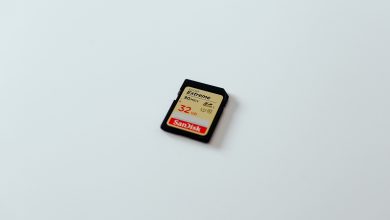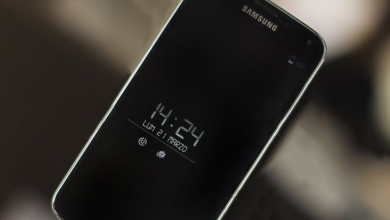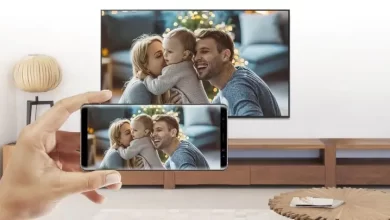Android Auto keeps Disconnecting? Try these Fixes
Android Auto disconnecting unexpectedly during use can be a significant problem, particularly when you’re in the middle of using navigation or other essential features. This issue often means that your phone is repeatedly losing its connection with your car’s infotainment system, which can happen either through a USB cable or wirelessly.
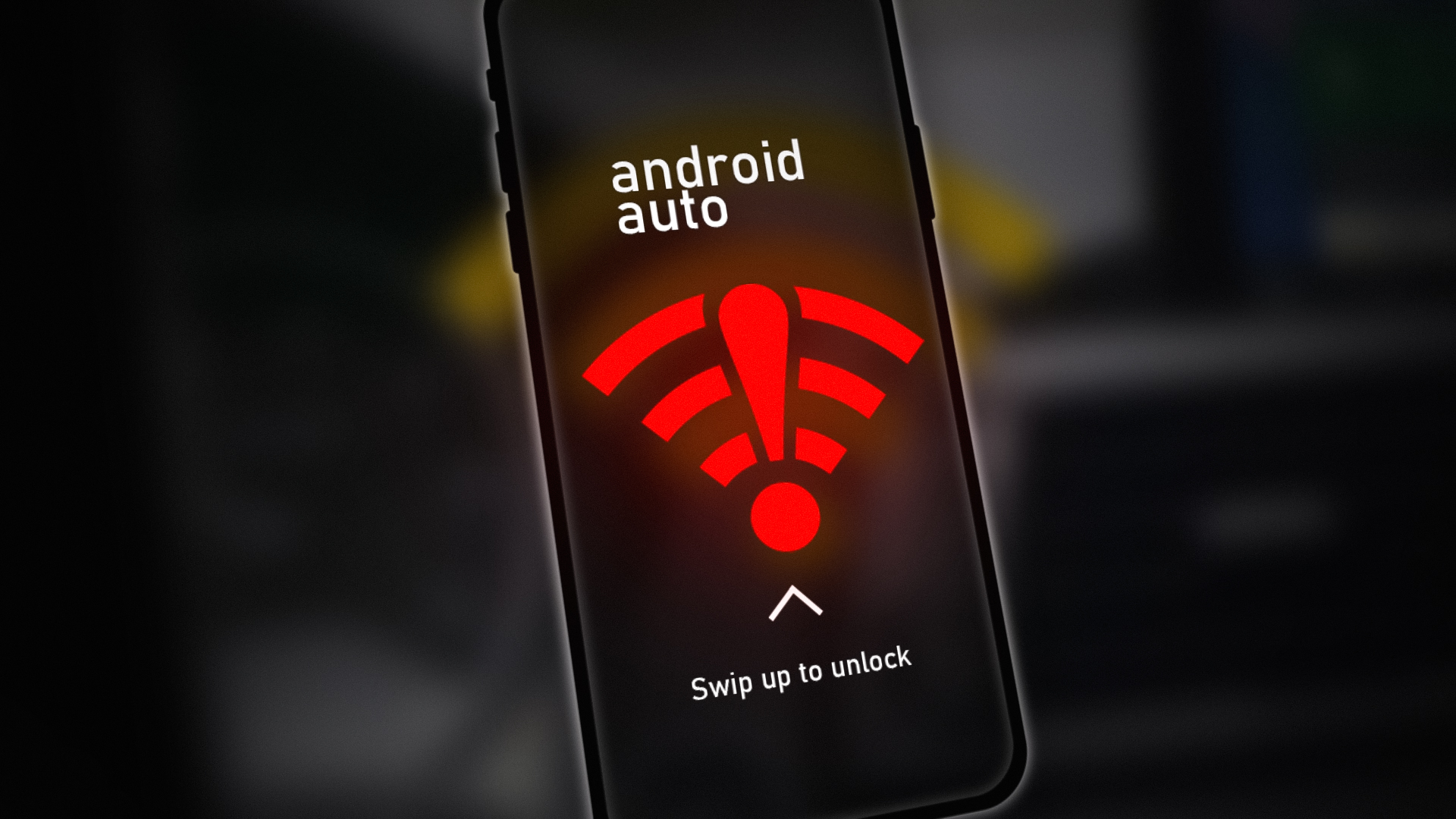
The most common cause of this problem is usually a faulty or incompatible USB cable, but it can also be due to software glitches or compatibility issues between your phone and the car’s system. Additionally, some users have reported that environmental factors, such as interference from other electronic devices or even certain geographic areas, can cause disruptions.
Update the Android Auto App to the Latest Build
The Android Auto app may keep disconnecting from the car’s entertainment unit if the app itself is outdated as it may have become incompatible with the car unit. In this context, updating the Android Auto app to the latest build may resolve the frequent disconnection issues.
- Launch the Google Play Store on the phone and open its Menu.
- Now select My Apps & Games and head to the Installed tab.

Open My Apps & Games in Play Store - Then, scroll down and open Android Auto.
- Now tap on the Update button (if an update is available), and once updated, restart your phone.

Update Android Auto - Upon restart, check if the Android Auto disconnection issue is resolved.
Clear Cache and Data of the Android Auto App
The disconnecting issue of the Android Auto app could be a result of the corrupt cache and data of the Android Auto app. Here, clearing the cache and data of the Android Auto app may solve the disconnection issue.
- Launch the phone’s Settings and select Application Manager (or Apps/Applications).

Open Apps in the Android Phone’s Settings - Now open the Android Auto app and tap on the Force Stop button.

Force Stop Android Auto and Open Storage - Then confirm to stop the Android Auto app and open Storage.
- Now tap on the Clear Cache button and check if the Android Auto issue is resolved.
- If not, once again clear the cache of the Android Auto and then tap on the Clear Data button.

Clear Cache and Data of Android Auto - Now, confirm to delete the data of the Android Auto app, and afterward, check if the Android Auto disconnecting issue is resolved.
- If that did not work, check if clearing the cache and data of the following applications solve the problem:
Google Play Store Google Play Music Google Maps
Clean the USB Ports or Try Another USB Cable
Android Auto might fail to keep the connection alive if the USB cable gets disconnected from the phone or car. This can occur especially if there is lint or debris in any of the USB ports (phone, car, or USB cable) and the USB jacks cannot be fully inserted into the USB ports. Also, if a non-stock phone cable is used to connect the phone and car, then it can also cause the issue. Here, cleaning the USB ports of the devices/cables or trying another USB cable may solve the problem.
- Find a pointy object (like a needle, toothpick, folded piece of paper, etc.) and gently clean the USB contact pins of the devices/cable but make sure not to damage the contacts.
- Then reconnect the devices and check if the Android Auto is working fine.
- If not, check if using the phone’s stock cable to connect the devices solves the problem.
- If that did not work, check if using a special high-speed or data rate USB 3.1 cable (like an Anker cable) clears out the connection issue.
If the issue persists and is occurring when the car bumps, check if placing the phone on something soft (like a cushion) to absorb the bump’s shock reduces the disconnections.
Update the Google Play Services to the Latest Build
Google Play Services is one of the core applications of the Android OS and if it is outdated, then it can impact the complete operation of the phone, including Android Auto. In this context, you can fix the Android Auto connection by updating the Google Play Services to the latest build.
- Update the Google Play Services to the latest build and once done, restart your phone.

Tap on the Update Button - Upon restart, launch Android Auto and check if the disconnection issue is resolved.
If that did not work and the issue is occurring at a specific time/place, check if the electromagnetic interference from other cars/devices is not causing the issue there.
Disable Wireless Projection of the Android Auto
If the Wireless Projection is enabled in the Android Auto’s Settings and a user’s phone is connected to the car device with a USB cable, then this setting may affect the Android Auto’s ability to properly utilize the USB connection and thus cause the issue. In such a case, disabling the Wireless Projection in the Android Auto’s settings may solve the problem.
- Open the Android Auto’s Settings and disable Wireless Projection by toggling its switch to the off position.

Disable Wireless Projection in the Android Auto Settings - Now, launch the Android Auto and check if its disconnection issue with the car unit is cleared.
Update the Phone’s OS to the Latest Build
The incompatibility between the outdated OS of the phone with the latest firmware version of the car’s entertainment unit may lead to the frequent disconnections of the Android Auto, and updating the phone’s OS to the latest build may solve the problem.
- Launch the phone’s Settings and select System.
- Then select About Phone and open Software Update.

Tap on About Phone in Settings - Now tap on Check for Updates and if an update of the OS is available, install the update.

Check for Updates in the Android Settings - Once installed, restart the phone, and upon restart, check if the Android Auto keeps disconnecting issue is resolved.
Enable Do Not Disturb Mode of the Phone When Using Android Auto
The Android Auto disconnecting issue could be caused by a phone’s notification that conflicts with the Android Auto modules. In this case, enabling the Do Not Disturb mode of the phone may solve the problem.
- Swipe down (or up) on the phone’s screen to expand the Quick Settings menu and then tap on Do Not Disturb.

Enable Do Not Disturb Mode of the Phone - Now check if the Android Auto is working fine. If so, then you may try to find the application’s notification causing the issue and streamline the issue between the app and Android Auto.
Disable the Auto Rotate Feature of the Phone
The auto-rotate feature helps to rotate the screen when the phone’s orientation is changed. However, the Android Auto app is not good at handling a sudden change in the phone’s orientation (either by a person or a car bump), which may cause the issue at hand.
- Open the Quick Settings menu of the phone (either by swiping down or up on the phone’s screen) and tap on Auto Rotate to disable it (if enabled).

Disable Auto Rotate Feature of the Phone - Now launch the Android Auto app and check if it is operating fine.
Correct Date/Time on the Phone and Car’s Entertainment Unit
When the date and time on your smartphone and car’s infotainment system are out of sync, it can lead to communication errors that disrupt the connection between them. Android Auto relies on precise time stamps to authenticate and maintain a stable connection.
If the time settings are incorrect, the system might struggle to sync data properly, leading to frequent disconnections.
- Launch the phone’s Settings and open Date & Time (in the System section).
- Now disable Automatic Date & Time and Automatic Time Zone by toggling the respective switches to the off position.

Disable Automatic Time and Time Zone - Then set the correct date and time on the phone.
- Now launch the car unit’s settings (e.g., Kenwood KDC 138) and find the clock adjustment option.
- Now adjust the car unit’s date/time as per the make/model instructions and afterward, check if the Android Auto is clear of the disconnecting issue.
If the issue persists, make sure the problematic phone is enabled in the car unit’s system settings and check if that resolves the issue.
Disable Battery Optimization of the Android Auto
If the battery optimization feature of the phone is killing the Android Auto modules in the process of extending the mobile’s battery, then Android Auto may show the disconnection issue at hand. In this scenario, disabling the battery optimization of the Android Auto in the phone’s settings may solve the problem.
- Launch the phone’s Settings and open the Battery.

Open Battery Optimization Settings - Now select Battery Optimization and set Android Auto to Do not Optimize.

Disable Battery Optimization for Android Auto - Then launch the Android Auto and check if its disconnecting issue is cleared.
- If not, then check if disabling the Battery Optimization for the Google Play Services solves the problem.
Keep in mind some phone models (like LG V10) may also show the Game Optimizer option; if so, make sure to exempt Android Auto in there as well. Some phone models (like Galaxy Note 10+) may have an option for App Power Management; if so, make sure to exempt Android Auto to not put to sleep by the OS.
Disable Wi-Fi Switching of the Phone
If the user’s phone is configured to use Wi-Fi switching (to switch to the best Wi-Fi available or switch to mobile data if the Wi-Fi signals are weak), then Android Auto may get disconnected from the car’s unit as it gets stuck in fetching data from the servers due to the Wi-Fi switching.
- Open the phone’s Settings and select Wi-Fi.
- Now select Wi-Fi Preferences and disable Intelligently Select the Best Wi-Fi.

Disable Intelligently Select the Best Wi-Fi - Then check if the disconnecting issue of the Android Auto is cleared.
- If not, disable the option of Switch to Mobile Data When Wi-Fi Internet Connection is Slow in the Wi-Fi Preferences and check if that resolves the Android Auto issue under discussion.

Disable Switch to Mobile Data Automatically
Update the Firmware of the Car’s Entertainment Unit to the Latest Build
Updating your car’s entertainment unit firmware fixes bugs, improves compatibility, and helps it work better with the latest version of Android Auto. If the firmware is old, it might not connect well with your phone, leading to disconnects.
- Download the firmware from the car’s unit from the OEM’s website (like Kenwood) and extract it (if zipped).
- Now copy the extracted file to a USB drive. Make sure the USB does not have any other data.
- Then, make sure the car’s entertainment unit is powered off and connect the USB to the unit.
- Now power on the entertainment unit and when it asks to update, tap on Yes.

Update the Firmware of the Car’s Unit - Then wait till the unit’s firmware is updated. Make sure the entertainment unit does not power off during the process or the USB gets disconnected.
- Once done, restart the unit and connect it to Android Auto to check if its disconnecting problem is solved.
Enable USB Debugging on the Phone and Edit the Relevant Settings in the Phone’s Developer Options
If a USB cable is being used to connect the phone with the car’s stereo or head-up unit, then enabling the USB debugging on the phone may solve the problem as it sets the USB modules as per the Android Auto cable requirements.
- Firstly, enable the Developer Options on the phone and then launch the phone’s Settings.
- Now select Developer Options and tap on the toggle of USB Debugging.

Open Developer Options - Then confirm to enable USB Debugging and afterward, check if the Android Auto’s disconnection issue is resolved.

Enable USB Debugging
Set Networking Options to Default USB Configuration
- Open the Developer Options of the phone and scroll to the Networking Options.
- Now select Default USB Configuration and enable Transfer Files (or PTP/Transferring Images).
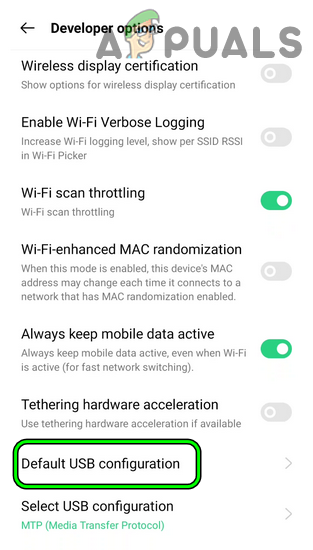
Set Default USB Configuration to File Transfer - Then launch Android Auto and check if it is functioning normally.
- If not, check if setting the Default USB Configuration to Charging Only solves the problem.
If that did not work, check if connecting the USB hub to the car’s unit and then connecting the phone to that hub resolves the Android Auto issue.
Enable Stay Awake in the Developer Options
- Launch the phone’s Settings and open Developer Options.
- Now enable the option of Stay Awake and check if the Android Auto is operating normally.

Enable Stay Awake in the Phone’s Developer Options
Reinstall the Android Auto App
Reinstalling the Android Auto app removes any corrupted files or settings that might be causing disconnections. When you reinstall, the app is restored to its default state, eliminating any glitches that developed over time. This process ensures that the app is up-to-date and free from errors, helping to establish a more stable connection with your car’s system.
- Launch the phone’s Settings and open its Application Manager (or Apps/Applications).

Open Apps in the Android Phone’s Settings - Now select Android Auto and tap on the Uninstall button.

Tap on Android Auto - Then confirm to uninstall the Android Auto App and once done, restart your phone.

Uninstall the Android Auto - Upon restart, reinstall the Android Auto app and check if the disconnecting problem is cleared.
Uninstall or Disable the Conflicting App on the Phone
If an app on the phone conflicts with the Android Auto app, then it may result in the disconnection issue of Android Auto. In such a case, uninstalling the conflicting app may solve the problem. The Spotify app is reported by users to cause the Android Auto issue at hand.
- Launch the phone’s Settings and open Spotify.
- Now tap on Disable and then Confirm to disable the Spotify app. Some users may have to uninstall the Spotify app.

Disable Spotify in the Android Settings - Then launch the Android Auto app and check if its disconnection issue with the car unit is resolved.
- If not, check if not increasing the car’s volume when Android Auto is in use clears out the error.
If the issue persists, check if deleting the phone from the car’s unit, switching off the car, deleting the car’s device in the phone’s/Android Auto settings, clearing the cache/data of the Android Auto app, and then reconnecting the phone to the car solves the problem.
If that did not work, then check if using Pandora while Android Auto is functioning clears out the problem. If you are using a wireless charger, note that Android Auto along with Google Maps (especially when satellite images are enabled), GPS, or other related apps drain a lot of battery from the phone, and the wireless charger may not fulfill the requirements. Using a USB cable charger may solve the problem. If none of the above did the trick, check if using Bluetooth to connect the devices solves the problem, or try using another phone.
